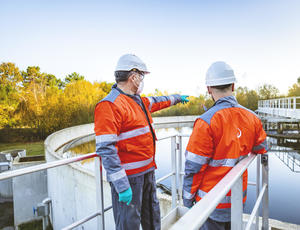A biological wastewater treatment solution combining activated sludge and moving bed biofilm reactor (MBBR) processes for nitrogen removal.
Overview
Hybas™ is an Integrated Fixed Film Activated Sludge (IFAS) solution requiring little process volume to achieve a reduction in organic material and nitrogen.
This technology by AnoxKaldnes — a subsidiary of Veolia Water Technologies — is a cost-effective way to upgrade an existing activated sludge process to either integrate nitrogen or full biological nitrogen removal or to simply enhance your existing nitrogen removal capacity. Hybas can also be a solution for greenfield plants where efficiency and footprint are key drivers.
With Hybas, moving bed biofilm reactor (MBBR) carriers are strategically added to the whole or a part of the aerated activated sludge volume. High amounts of nitrifying bacteria are enriched on the carriers while dissolved oxygen demand (BOD) removal and denitrification occur in the suspended phase.
This solution improves nitrification and reduces the sludge load on secondary clarifiers. Denitrification is also improved, as the sludge age in the activated sludge is reduced, and the risk of filamentous bacteria is reduced.
With over 20 years’ experience and more than 100 global references across municipal and industrial markets, Hybas’ key features and benefits include:
- Effective nitrogen removal to protect human health and aquatic environments.
- Upgrading existing infrastructure with limited civil works.
- Proven to enhance micropollutant treatment.
- Improved biogas production over conventional systems.
- Robust nitrification.
- Reduces filamentous growth/bulking sludge.
- Easy to combine biological phosphorus removal.
- Easy to add pre- and post denitrification to reach low total nitrogen.
- Less sensitive to load and temperature variations.
Applications
Services
We offer a range of services from process support contracts, laboratory trials and diagnostic microscopy. We also provide:
Contact
When treated wastewater containing nitrogen, phosphorus and other nutrients enter our waterways these nutrients can encourage algal growth. The same algae use oxygen when it decomposes and so it can suffocate aquatic life and potentially damage fishing territories. With Hybas wastewater treatment, plant managers can fully remove these nutrients to protect our environment while also adding robustness and greater capacity to their site.

Luca Quadri
Deputy Sales Director
Contact Luca through his LinkedIn account
Case Studies

The wastewater treatment plant (WWTP) was running out of capacity with its previous activated aludge and clarifier treatment line and at the same time it was facing increasing and varying loading conditions. A combination solution to reach an overall capacity of 52,000 people equivalent, featuring Hybas, was chosen because it allowed for maximum flexibility and efficiency in a very small footprint. The space saving on the agricultural farms land outside the plant was also key.

With a population of 48,000, the City and County of Broomfield, need to enhance its wastewater treatment plant (WWTP) to meet increasing effluent guidelines for phosphorus, ammonia and nitrate removal and reduce biochemical oxygen demand from their wastewater. Hybas™ was selected as it was not only the most cost-effective technology but it meant the WWTP could be upgraded from 5.4 million gallons per day (MGD) to 8.0 MGD without increasing the volume of its aerobic tank.

A contract to reconstruct the wastewater treatment plant (WWTP) with an increased treatment capacity of 700,000 cubic meters a day, serving 620,000 residents. It comprised four treatment lines: wastewater, stormwater, sludge treatment and deodorization. Hybas ensures biological treatment and helps reduce the plant's carbon footprint.








